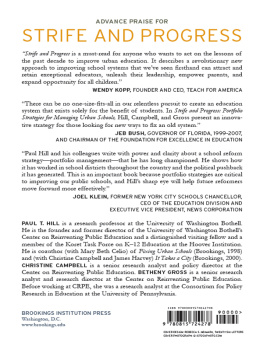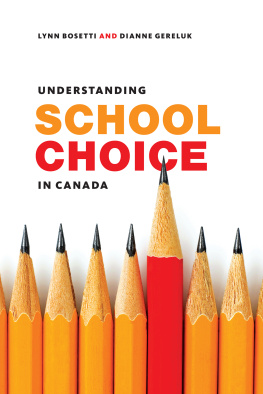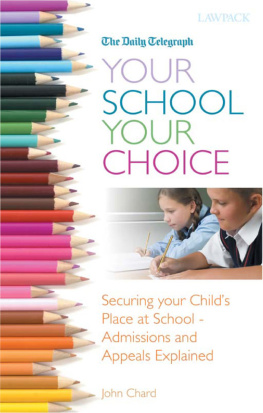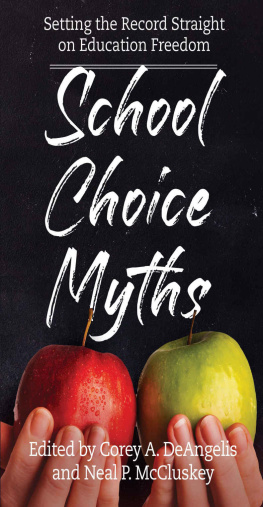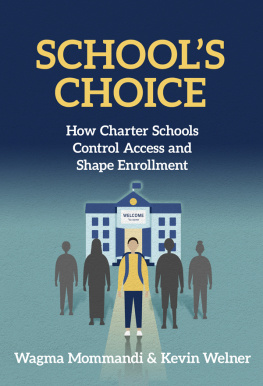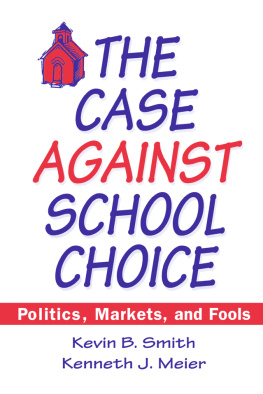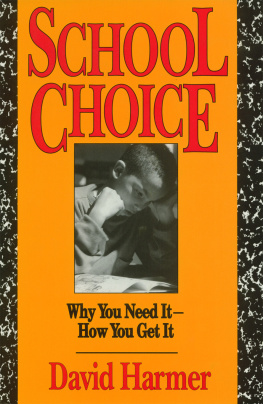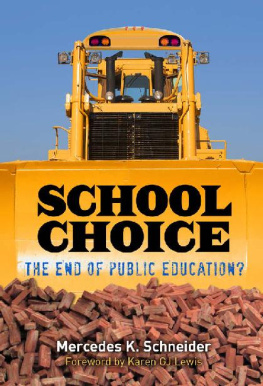WILLIAM E. SIMON FOUNDATION
The Hoover Institution on War, Revolution and Peace, founded at Stanford University in 1919 by Herbert Hoover, who went on to become the thirty-first president of the United States, is an interdisciplinary research center for advanced study on domestic and international affairs. The views expressed in its publications are entirely those of the authors and do not necessarily reflect the views of the staff, officers, or Board of Overseers of the Hoover Institution.
The paper used in this publication meets the minimum requirements of the American National Standard for Information SciencesPermanence of Paper for Printed Library Materials, ANSI Z39.481992. 
Cataloging-in-Publication Data is available from Library of Congress.
ISBN-13: 978-0-8179-1014-3 (hardback : alk. paper)
ISBN-13: 978-0-8179-1013-6 (e-book version)
To Alice, who always wants to know how things work.
PREFACE
In education policy, the terms of debate are usually badly framed. Reformers claim that a desired action (e.g., higher standards, performance-based pay, or new spending), will lead to better schools all by themselves, even if nothing else changes. That is never true. But opponents of change, often those who stand to lose position or privilege if a proposed measure is adopted, use an equally flawed argument. They claim that since whatever change they are fighting against can't solve every problem, then it should not be tried. Hence, one side claims that a measure is sufficient when, at best, it is necessary, while the other claims that the same measure is not necessary because it is not sufficient.
School choice, the most hotly contested issue in public education, gets such treatment.
The consequences of bad framing became painfully clear to me during a debate staged by my colleagues on the Hoover Institution's Koret Task Force on K12 Education. The question posed for debate was whether choice or curriculum was the key to more effective schools. Debaters on both sides had to act as if they did not know the important issues. Those assigned to argue against choice had to forget that the rigorous curriculum, developed by one of them, was used much more often in schools of choice than in district run public schools. Few public school districts could support a curriculum that was as focused and demanded so muchwork from teachers and students. Those arguing for choice had to act as if they believed choice led directly to better schools, rather than it acting indirectly by giving school leaders the freedom to implement coherent curricula and allowing parents to avoid curricula they dislike and find ones that work for their children. The silliness of the question made for an entertaining debate, but the store of human knowledge did not increase that day.
What the debate made obvious is that the real argument for choice is complex and conditional, not simple. Forces of competition and freedom are real but don't guarantee success every time. Moreover, opponents can block or slow down choice, and opportunists can corrupt it.
Choice programs are embattled in public education, but they exist. Are their successes obvious to the naked eye of any honest observer? No. Instead, these successes are uneven and the results are often so subtle that serious people can debate whether they are real or are instead artifacts of research and analysis techniques.
How then do we understand how choice works when it does, and what slows it down or blocks it? Explaining those subtleties is the business of this book. It arises from years of thinking about choice, playing with causal models, looking at evidence, and arguing with friends.
Acknowledgments
My current and past colleagues in this endeavor on the Hoover Institution's Koret Task Force on K12 Education, John Chubb, Williamson Evers, Checker Finn, Eric Hanushek, E.D. Hirsch, Caroline Hoxby, Tom Loveless, Terry Moe, Paul Peterson, Diane Ravitch, and Herbert Walberg were critical and influential friends. They didn't write this book, and maybe wouldn't have written anything like it, but they were indispensable to its development.
I also owe debts to long-time collaborators at the Center on Reinventing Public Education, Robin Lake, Dan Goldhaber, Ashley Jochim, Sam Sperry, and James Harvey; to Bruno Manno, Jane Hannaway, Howard Fuller, the late Tom Glennan, Jeff Henig, Dean Millot, and Tony Bryk; and to members of the Brookings Institution commission I led on Doing School Choice Right. All of them, by putting up with my speculations and tracing my flow diagrams, encouraged me to consider choice not as a magic potion but as a normal public policy intervention whose results depend on many things.
Thanks also to the Hoover Institution staff for steady support, particularly director John Raisian, senior associate director Richard Sousa, and associate director Eryn Witcher (communications director). Additionally, I would like to thank copyeditor Barbara Egbert.
Also a big thanks to Center on Reinventing Public Education staffer Deb Britt, who makes sure my writing is at least arguably in English.
CHAPTER 1
INTRODUCTION
Have publicly funded school choice programscharter schools in forty-three states and vouchers in a few localitiesbeen qualified successes or crashing failures? Only sworn opponents of school choice will argue for failure, but no one can argue that it has been an overwhelming success. Neutrals and choice supporters alike will agree that these initiatives have been qualified successes. Even the most rigorous studies of student achievement in charter and voucher schools find some dramatic successes and many mixed results.
How does this square with the rhetoric of choice supporters who promised much more effective schools and an era of innovation? Predictions of quick and dramatic success for school choice were in part the normal over-promising associated with advocacy. But to my knowledge choice supporters didn't consciously make inflated predictions. Even in secret, choice supporters did not say to one another, This will take a long time and the early results will be meager but we can't admit that publicly. To the contrarystrong choice supporters were the truest believers.
Is there something wrong with the theories behind the school choice movement? No, indeed. But are the theories valid as generalizations but too simple to predict real events, and much slower to act than choice supporters expected? The answer is yes. The theories behind school choice are valid in the same sense that Newton's basic equations in physics are valid: they identify inexorable forces and fundamental relationships but in doing so they assume idealized conditions that are never perfectly met in the real world. To explain, predict, or control real events one would have to take account of factors the theories assume away, like friction and atmospheric pressure in the case of Newton's laws of motion. The same is true of theories of human or market behavior. This book will consider the real-world factors that can complicate, delay, and even in some instances interfere with the cause-and-effect relationships identified by the theories behind school choice.


